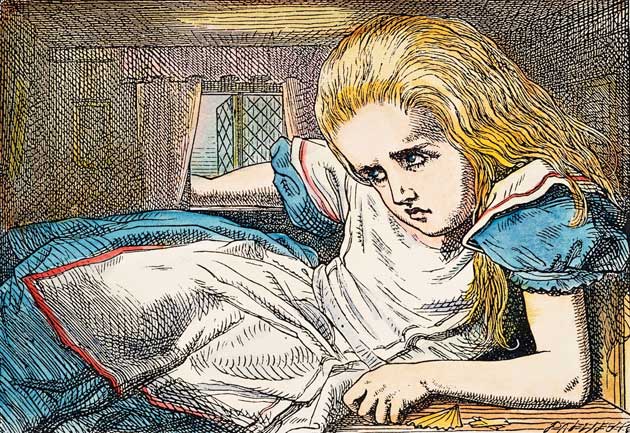Great Works: Alice Overgrowing The Room, (1865), John Tenniel

There are proverbs among images, and among the most proverbial are the illustrations John Tenniel drew for the Alice stories. His pictures of the Cheshire Cat, the Mad Hatter’s Tea Party and Humpty Dumpty have passed into folk recognition. One of the mostmemorable is from Alice’sAdventures in Wonderland; an early scene, “Alice Overgrowing the Room”.
Alice has taken the potion. “She went on growing and growing, and very soon had to kneel down on the floor: in another minute therewas not even room for this, and she tried the effect of lying down with one elbow against the door…” What enchants Tenniel’s picture is the way he gives this physical predicament a specifically pictorial realisation.
The trick is two-cum-three-dimensional entrapment. Alice’s head ducks beneath the ceiling and beneath the top edge of the picture. The crook of her elbow sticks into the corner of the room and into the picture’s corner. The box of the chamber equates with the picture’s oblong. The figure is confined by both.
Some of Tenniel’s work has been sourced to paintings. The Duchess is modelled on Quinten Massys’s A Grotesque Old Woman. Jabberwocky may derive from a demon by Salvator Rosa. The railway carriage scene matches Augustus Egg’s Travelling Companions.TheWhite Knight echoes Millais’s Sir Isumbras at the Ford.
No art source has been found for “Alice Overgrowing the Room”. But its leading device, two-cum-three-dimensional entrapment, has artistic precedent.It’s used in Holbein’s frightening painting of Dead Christ. Jesus’s skeletal corpse is laid out, full length, viewed side on in a shallow, open-sided coffin, whose edges coincide with the picture’s cramping letterbox format.
That is only a formal analogy. Though Alice has no doubt been compared to Christ, here she is a living, struggling body. Perhaps a Gothic fear of being buried alive lurks, but a better likeness isn’t tomb, but womb. At least, that is implied in an image that certainly did guideTenniel’s imagination. Lewis Carroll’s original manuscript of the story, called Alice’s Adventures UnderGround,was written and drawn by the author himself, and carry his own illustration to this episode. Carroll’s image is partly followed by Tenniel and partly not. There is gain and loss. Carroll lacks Tenniel’s competences. His drawing is cruder. Tenniel’s drama is strong, establishing Alice’s body as a solid entity, imprisoned and straining within room and frame. Carroll has a much less definite sense of the distinction between the figure and its picture – which makes his version the more daring.
Alice is folded in a foetal position. Her body does not push beyond the frame. She’s tucking herself up snugly within its limits. She doesn’t seem to resist her confinement. No arm pokes through a window, for Carroll gives no hint of a room at all. Alice is pressed flat up against the front of the image. She’s an ink and paper creature. What contains her is only an outlined frame, and she fills it almost entirely. Within that, her insecurely drawn anatomy drifts and swims. Unsubstantial, the figure doesn’t stand out against its picture. It’s fused in a symbiosis. The effect is dreamlike, amniotic.
This image is too vague ever to acquire the proverbial status of Tenniel’s. And Carroll probably didn’t know of William Blake. But, on wings of amateurism, he flies here to the edges of the visionary.
About the artist
Sir John Tenniel (1820-1914) was the leading English cartoonist and illustrator of his age, at a time when these professions had become sufficiently established and dignified that a practitioner could be offered, and accept, a knighthood. (With Gillray it would have been unthinkable.) Tenniel drew for ‘Punch’ for 50 years. His most famous political cartoon was ‘Dropping the Pilot’, about the end of Bismarck. His inclinations were first towards fine art, and he never abandoned them. He designed the mosaic of Leonardo in the Victoria & Albert Museum. But his pictures to ‘Alice’ remain his testament, and have outlived and outspread his name itself.
Subscribe to Independent Premium to bookmark this article
Want to bookmark your favourite articles and stories to read or reference later? Start your Independent Premium subscription today.

Join our commenting forum
Join thought-provoking conversations, follow other Independent readers and see their replies